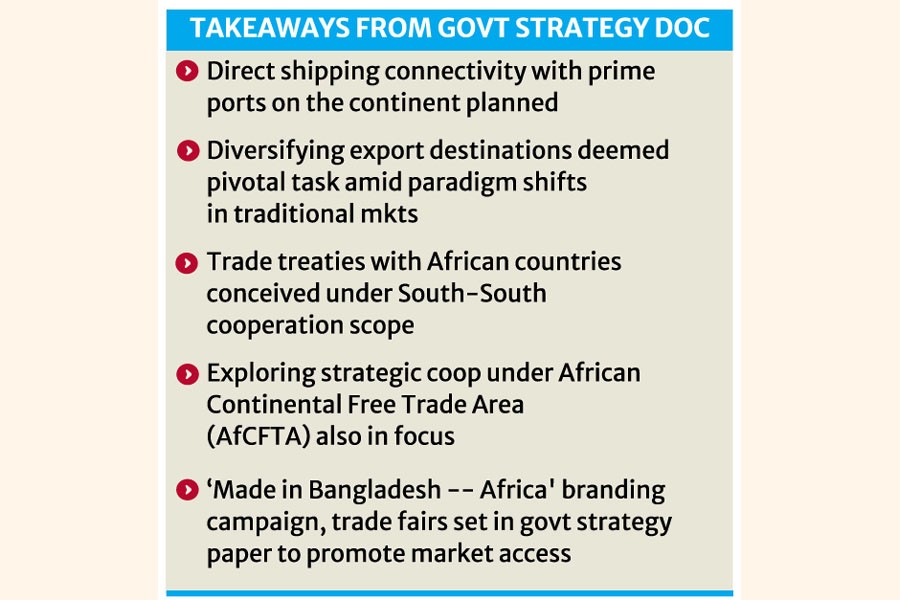
Published :
Updated :

Bangladesh moves to discover trade treasure troves across Africa with an imminent exploration mission and trade summit under a comprehensive plan for export-market diversification into potential destinations yet untapped.
Sources say direct shipping connectivity with prime ports on the continent planned and striking trade treaties with African countries under South-South cooperation avenues are also components of the trade-and investment-promotion blueprint.
A particular focus of the plan is on fostering ties with the Southern African Development Community (SADC). As part of this initiative, the government plans to host an Africa-Bangladesh Trade and Investment Summit in Dhaka this December.
According to sources at the Ministry of Commerce, the Export Promotion Bureau (EPB) will organise the summit, aimed at enhancing trade and investment ties with the African economies.
The initiative primarily moves on a just-prepared strategy paper titled 'Unlock Export Opportunities in SADC Countries', which outlines a detailed roadmap to expand Bangladesh's export footprint within the 16-member bloc encompassing major economies.
Prior to the Dhaka conclave, the government has scheduled a trade-delegation mission to major SADC countries in November, according to the commerce ministry sources.
The SADC region -- which includes countries such as South Africa, Tanzania, Angola, Mozambique, Zambia, and Zimbabwe -- has been identified as a largely untapped but promising market.
With a combined GDP of approximately US$850 billion and a population of over 380 million, the region presents significant opportunities for Bangladesh to reduce its reliance on traditional export destinations in the European Union and North America.
Currently, Bangladesh's trade with the region remains modest. In FY2024-25, total exports to Africa came to US$410.8 million, of which about US$158.9 million worth of the trade went to SADC countries. South Africa emerged as the largest importer within the bloc. Key export items include ready-made garments (RMG), jute goods, pharmaceuticals, leather, and agricultural products.
The EPB-drafted strategy paper carries a call for a coordinated approach to removing trade barriers, enhancing logistics infrastructure, and supporting product diversification in preparation for the up-and-coming trade bonanza.
Outlined in the blueprint are seven key priority areas: product diversification, bilateral trade agreements, improved logistics and connectivity, financial facilitation, country branding, Institutional capacity building and strengthened compliance with international quality standards.
The government has set a target to increase exports to the SADC region to US$2.5 billion by 2030. To this end, the paper recommends initiating trade-and investment agreements with key SADC economies like South Africa, Tanzania, and Mozambique, while also exploring strategic cooperation under the African Continental Free Trade Area (AfCFTA).
Additionally, plans are in motion to establish direct shipping routes between Chattogram seaport and major African ports such as Durban, Maputo, and Dar es Salaam, which could significantly reduce freight costs and transit times.
Several Bangladeshi business groups have already started looking for prospects in African markets. Sectors showing strong growth potential include pharmaceuticals, agro-processed foods, leather goods, light engineering, plastics, and ICT services.
To further promote market access, a recommendation has been made for launching a 'Made in Bangladesh -- Africa' branding campaign and organising trade fairs in South Africa, Tanzania, and Zambia, according to the government strategy paper.
However, the report also identifies several challenges, including the absence of preferential trade agreements, tariffs ranging 15-25 per cent, limited logistics and banking infrastructure, and cut-throat competition from global players like China, India and Turkey.
To address these issues, the paper proposes enhanced financial instruments such as export-credit guarantees, establishing correspondent banking relationships, and streamlining letter of credit (LC) procedures for Africa-bound shipments.
Trade analysts view the initiative as a key pillar of Bangladesh's evolving 'Look South' policy, which seeks to deepen South-South cooperation and shift export reliance away from saturated Western markets.
"If the roadmap is implemented effectively, the SADC region could become a significant growth frontier for Bangladesh's export sector, helping the country reach its US$2.5 billion target by 2030," says one trade expert.
Speaking to The Financial Express, EPB Vice-Chairman Mohammad Hasan Arif said: "We are planning to explore export opportunities in the African market. As part of that plan, trade delegations will be visiting the region."
He mentions that a high-level delegation is scheduled to visit five key SADC countries in early November, with the Commerce Adviser of the interim government expected to lead the mission.
The delegation will represent eight priority sectors, including RMG, agro-products, leather and footwear, pharmaceuticals, and IT services.
Arif hopes the upcoming Africa-Bangladesh Summit to bring together around 100 international buyers, and, maybe, held alongside 'Sourcing Bangladesh', the country's first global sourcing expo, scheduled for December 1-3 in Dhaka.
newsmanjasi@gmail.com


 For all latest news, follow The Financial Express Google News channel.
For all latest news, follow The Financial Express Google News channel.